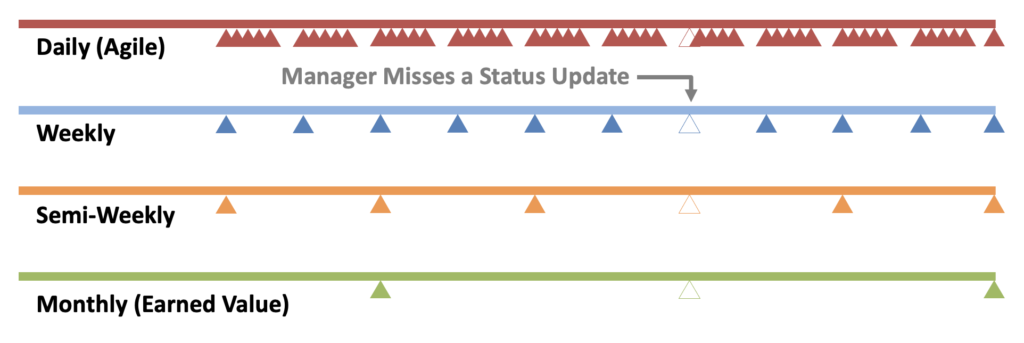Schedule analysis is the heart of Schedule Management. It tells project teams what they must do with the time and resources available to keep their commitments. A well-built, well-maintained schedule is a prerequisite for conducting schedule analysis, but if the analysis does not adequately inform stakeholders of the project’s future, the entire effort is wasted.
This article will discuss how Schedule Analysis’s three step process (Figure 5) relies on consistency and repeatability to build upon one another and sets the stage for more in-depth discussions of statusing, reviewing and reporting.
Schedule Analysis as a Process
Compared to schedule creation or maintenance, effective schedule analysis hinges upon maintaining a consistent process throughout the project’s life. Performing schedule analysis the same way and with the same input sources, insures trust in both the process and its findings. Schedule analysis always has the same three steps, always performed completely and in sequence.

Statusing
If analysis is the heart of Schedule Management, status updates are its lifeblood. Attempting any sort of schedule review or reporting without knowing the progress made to date is akin to planning a chess game’s next move without seeing the opponent’s pieces. Like the game underway in Figure 61Graphic created using Chess Videos TV. https://www.chessvideos.tv/puzzle-maker.php, cautious or reactionary steps can be taken, but the project team has no real understanding of what is happening.
Statusing the schedule requires the cooperation of all team members (usually managers or team leads) responsible for overseeing the completion of work on the project. In the case of very large projects and project schedules, statusing the schedule may require input from every member of the team.
Statusing is a very focused activity. When statusing the schedule, Schedule Managers concentrate only on recognizing task progress, or lack thereof. Only after the entire project has been statused should the Schedule Manager turn their attention to adjusting dependencies, recovering lost time, and other schedule updates.

Reviewing
Once the schedule has been statused, the real analysis begins. The Schedule Manager should review the schedule in two stages – alone, then with managers and team leads. Reviewing the schedule alone lets the Schedule Manager clean up any errors or artificial delays introduced during statusing, perform routine health checks, and identify areas which require attention during manager reviews. Reviewing the schedule with team leads is best done one-on-one or in small groups. Confidentiality fosters honesty. Effective schedule review meetings compel managers to recognize the delays and bottlenecks impacting their project while affording them an opportunity do something about it.

Ideally, schedule review meetings are low stress and collaborative. However, the team leads must prove to the Schedule Manager that their plan forward is plausible. The validity of a manager’s plan directly impacts the reliability of the schedule reporting, and every other team’s ability to plan their work. Just because a team lead wants to make up a two-week delay doesn’t mean they can. The Schedule Manager must guard the schedule against unrealistic expectations.
Reporting
Most stakeholders never look at the schedule file. They comprehend the project schedule by reading the reports derived from the schedule. In fact, it is not uncommon for some stakeholders to believe the reports are the schedule.
Stakeholders at all levels adjust their plans to compensate for the shifting nature of projects. But without up-to-date intel, they are working with blind spots that they may not even notice. Schedule reports which regularly produce bias-free, easy to understand information, are a boon for project teams. Decision quality information maximizes a project team’s options for staying in control of their work.
Repeating the Process
One of the most complicated decisions a project team must make involves setting the reporting frequency. This in turn impacts the schedule analysis cycle. How often should Schedule Managers conduct a full schedule analysis?
Industry standards recommend statusing and reviewing the schedule weekly. But regularity is the real key. While statusing the schedule can be labor intensive, a fixed process obligates team leads to incorporate the chore into their management routine. Statusing and reviewing the schedule erratically or infrequently turns the exercise from a chore into an interruption.
By statusing and reviewing the schedule more frequency, the importance of any single status update diminishes. Perhaps counterintuitively, the reduced importance of status updates benefits team leads and Schedule Managers alike. Every project is going to have interruptions. Team leads will occasionally miss statusing or reviewing their portion of the schedule.
Figure 7 illustrates this happening two months into the start of a project. If the schedule is analyzed weekly, the one missed update is a minor annoyance. When a monthly status update is missed, it’s the next best thing to disaster. Skip status updates and dentist appointments at your own peril, but not anyone else’s.

Finally, consider the number of opportunities for course correction weekly schedule statusing provides compared to semi-weekly or monthly statusing. Projects carry inherent unpredictability and risk. Problems are far easier to handle when they are first noticed as small problems. The bi-weekly and monthly analysis cycles increase the likelihood that the problems will be large, numerous and unavoidable when they are finally identified.
Of course, the schedule can also be over statused. Agile is a very effective development strategy which relies on daily statusing to keep scrum teams on top of their work. The tightly controlled process champions speed over thoroughness and does not use logic driven schedules to plan. Agile deliberately focuses on short term work with hazy long-term objectives. Beware of incompatible management strategies! Attempting to update and analyze a large logic driven schedule with the same frequency as a scrum or Kanban board will overtax project managers, preventing them from accomplishing anything, and obscure the schedule’s big picture.

Consistency is also crucial for reporting. Suppose a project team uses a semi-weekly analysis cycle. Every two weeks the schedule is statused, reviewed and reported on. But on the tenth day of every fiscal quarter, the client requires a special schedule and earned value report. Some quarters, the semi-weekly and quarterly reporting cycles will mesh. But often they will be out of step. Should the project team make a special exception to their process to squeeze in an update? Work hard to resist the temptation. As already discussed, disrupting the regular schedule analysis will aggravate project teams. And how necessary is the latest possible data for this report? Any stakeholders who are consuming schedule data once every three months (about thirteen weeks), can afford to read a report based on slightly older data. Better still, when the exact same schedule is used to populate both reports, readers will be able to make an apples-to-apples comparison between the reports.
Ownership of the Process
Since reports are the outcome of schedule analysis, all report content must trace directly back to data in the schedule file. Otherwise, both the schedule and the report will lack credibility. Whomever owns responsibility for producing schedule reports necessarily owns the project schedule. On a project with a dedicated Schedule Manager, the Schedule Manager must be the final authority regarding what goes into the schedule file and thus the reports. This is not unlike accounting where the project’s revenue and expenses are validated by a Certified Public Accountant (CPA) or the project’s Financial Manager.
Sometimes schedules convey bad news. Allowing managers to pretend that they are going to be on time does not actually make them on time. In fact, hiding or denying schedule variances often exacerbates delays by reducing response time, and multiplying the surprise’s eventual impact.2e.g. “For months you told me we were on schedule. What happened!” When the Schedule Manager controls the process, they have the ability and responsibility to help project teams recognize when things aren’t going as planned. Managers can only fix problems that they acknowledge.
Next Steps
Schedule Analysis Fundamentals discussed how analyzing the schedule is the crux of Schedule Management and its role in the project management process. Having covered how the three vertices of schedule analysis should build comprehensively upon one another, Schedule Analysis Techniques will overview the practical considerations of a reliable and sustainable analytical process.
